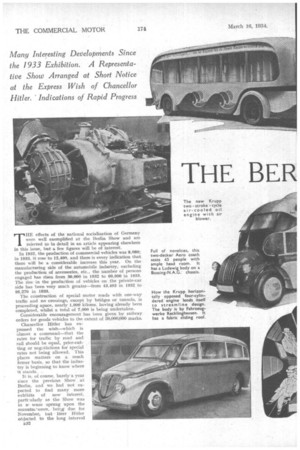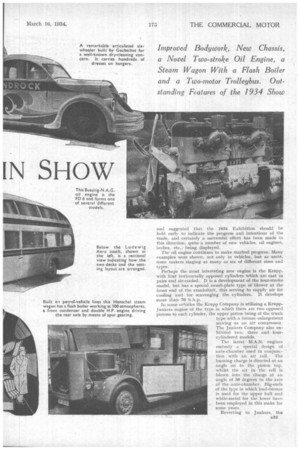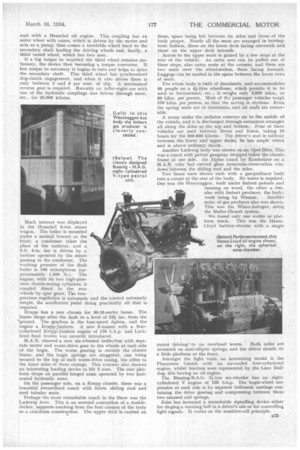THE BER IN SHOW
Page 42

Page 43

Page 44

Page 45

If you've noticed an error in this article please click here to report it so we can fix it.
Many Interesting Developments Since the 1933 Exhibition. A Representative Show Arranged at Short Notice at the Express Wish of Chancellor Hitler. Indications of Rapid Progress Improved Bodywork, New Chassis, a Novel Two-stroke Oil Engine, a Steam Wagon With a Flash Boiler and a Two-motor Trolleybus. Outstanding Features of the 1934 Show
THE effects of the national socialization of Germany were well exemplified at the Berlin Show and are referred to in detail in an article appearing elsewhere in this issue, but a few figures will be of interest.
In 1932, the production of commercial vehicles was 8,080; in 1933, it rose to 12,400, and there is every indication that there will be a considerable increase this year. On the manufacturing side of the automobile industry, excluding the production of accessories, etc., the number of persons engaged has risen from 30,000 in 1932 to 60,000 in 1933. The rise in the produztion of vehicles on the private-car side has been very much greater—from 43,403 in 1932 to 95,270 in 1933.
The construction of special motor roads with one-way traffic and no crossings, except by bridges or tunnels, is proceeding apace, nearly 1,000 kiloms, having already been completed, whilst a total of 7,000 is being undertaken.
Considerable encouragement has been given by railway orders for goods vehicles to the extent of 30,000,000 marks.
Chancellor Hitler has expressed the wish—which is almost a command—that the rates for traffic by road and rail should be equal, price-cutting or negotiations for special rates not being allowed. This places matters on a much firmer basis, so that the industry is beginning to know where it stands. .
It is, of course, barely a year since the previous Show at Berlin, and we had not expected to find many more exhibits of new interest, parti7ularly as the Show was in a% sense sprung upon the manutac..'urers, beir,g due for November, but Herr Hitler objected to the long interval and suggested that the 1934 Exhibition should be held early to indicate the progress and intentions of the trade, and certainly a successful effort has been made in this direction, quite a number of new vehicles, oil engines, bodies, etc,. being displayed.
The oil engine continues to make marked progress. Many examples were shown, not only in vehicles, but as units, some makers staging as many as six of different sizes and types.
Perhaps the most interesting new engine is the Krupp, with four horizontally opposed cylinders which are cast in pairs and air-cooled. It is a development of the four-stroke model, but has a special swash-plate type of blower at the front end of the crankshaft, this serving to supply air for cooling and for scavenging the cylinders. It develops more than 70 b.h.p.
In some vehicles the Krupp Company is utilizing a Krupp Junkers engine of the type in which there are two opposed pistons to each cylinder, the upper piston being of the trunk type with a bronze enlargement serving as an air compressor. The Junkers Company also exhibited two, three and fourcylindered models.
The latest M.A.N. engines embody a special design of ante-chamber used in conjunction with an air cell. The burning charge is directed at an angle on to the piston top, whilst the air in the cell is blown into the charge at an angle of 30 degrees to the axis of the ante-chamber. Big-ends of the type in which lead-bronze is used for the upper half and white-metal for the lower have been employed in this make for some years.
Reverting to Junkers, the latest aero oil engine has six cylinders, develops 540 b.h.p., and runs at 2,200 r.p.m., this being reduced to 1,400 r.pm. propeller speed. Without propeller the weight is 1.091 lb., or 1.98 per b.h.p. There are two pumps and four atomizers for each cylinder, and in emergency the air supply can be arrested, which stops the engine. In this model the upper air compressors are not used, a blower at the end opposite the propeller feeding the cylinders. Under full load the fuel consumption is .363 lb. per b.h.p.-hour, and the range, compared with that of a similar aeroplane with a petrol engine, is increased by some 54 per cent.
The Henschel continues to employ the Lanova combustion system, which has proved highly efficient and is the product of the inventor of the Acro system. The cylinder head embodies two circular compartments in communication. At one side of the channel between them is the horizontal injector, and at theother an air-storage chamber which can be varied in volume to give a higher compres
sion for starting. An extremely rapid double whirling effect is given.
Bfissing N.A.G. displayed several units. The antechambers and the injectors on these are vertical. Each chamber finishes in a small bore, and at the base the mix..
tare is led into the cylinder at an angle and almost tangentially, to give a high degree of turbulence.
Vomag still uses the Oberhaenslie, in which a spherical combustion chamber at the side of the cylinder bore is given a clearance from the head casting, except around its seat, and thus forms a hot body into which the fuel is sprayed. Humboldt-Deutz engines were shown in types ranging from 60 b.h.p. to 150 b.h.p. They embody vertical ante-chambers and are of particularly clean design.
One of the most striking exhibits on entering the commercial show was the Mercedes-Benz-Metz 30-metre turntable all-steel ladder with oil-driven mechanism. Similar
B34
models have been sold to Manchester, Liverpool, Birmingham, etc. It has pendulum automatic control to prevent overbalancing, whilst just a touch of the top of the ladder against a wall when moving from one side to the other, dropping on to a parapet or lifting against a roof instantly arrests the mechanism, so that there can be no straining. An indicator hand, light signals and a bell draw attention to the contact. The control is all mech4ca1, not electrical.
Amongst fire-engines, Magirus Showed' a fine semi-limousine type with centrifugal pump at the front. Faun had a fine show of municipal appliances, such as sweepers, refuse collectors and cleansing,rnachines. These will be referred to in an article to be published shortly. One of the Mercedes-Benz exhibits was a mobile workshop, including a kitchen. Each tool had its own driving motor.
Amongst the new chassis was a Hansa-Lloyd 4-tormer with dropped cross-members carrying above them a" twopiece propeller shaft, braking being effected by a huge single Bosch Dewandre servo. There was also a new, sixcylinder 1-tonner with two-piece shaft, low frame and four speeds. This sold at 2,480 marks. The remarkable Hanomag chassis with its oil engine horizontally disposed across and under the frame has now been developed as a four-wheel-driving-and-steering machine with double reduction to the front and rear axles. An example with rear-wheel drive was shown as a bus with forward control and central entrance. We observed that an emergency door was lacking.
The biggest vehicle exhibited was the Gaubschat articulated six-wheeler equipped as a dry cleaner's showroom and carrier with large windows and hundreds of dresses on hangers along the sides. An elaborately equipped travelling shop of this make was shown outside.
The Henschel rigid six-wheeler has curious spring seats for the bogie axles, each seat being connected to the axle by four fabric discs. Each of the axles has overhead-worm drive.
Shown separately on the Henschel stand was a hydraulic combined torque converter and coupling mounted as a
unit with a Henschel oil engine. This coupling has an outer wheel with vanes, which is driven by the motor and acts as a pump; then comes a turntable wheel fixed to the secondary shaft leading the driving wheels and finally, a third vaned wheel, which has two uses.
If a big torque be required the third wheel remains stationary, the device then becoming a torque converter. If less torque be necessary it begins to turn and helps to drive the secondary shaft. This third wheel has synchronized dog-clutch engagement, and when it also drives there is only between 2 and 3 per cent. of slip. A mechanical reverse gear is required. Recently an Adler-eight car with one of the hydraulic couplings was driven through snow, etc., for 20,000 kiloms.
Much interest was displayed in the Henschel 5-ton steam wagon. The boiler is mounted under a normal bonnet at the front; a condenser takes the place of the radiator, and a 2-ft. 6-in. fan is driven by a turbine operated by the steam passing to the condenser. The working pressure of the flash boiler is 100 atmospheres (approximately 1,500 lb.). The engine, with its two high-pressure, double-acting cylinders, is coupled direct to the rear wheels by spur gears. The temperature regulation is automatic and the control extremely simple, the accelerator pedal doing practically all that is required.
Krupp has a new chassis for 30-35-seater buses. The frame drops after the dash to a level of 23R ins. from the 'ground. The gearbox is the four-speed Aphon, and the engine a Krupp-Junkers. A new 5-tonner with a fourcylindered Knipp-Junkers engine of 120 b.h.p. and Lockheed fluid brakes was recently introduced.
M.A.N. showed a new six-wheeled trolleybus with separate motor and worm-drive gear to the wheels at each side of the bogie. The worm gearing is outside the chassis frame, and the bogie springs are staggered, one being secured to the top of each worm-drive casing, the other to the inner sides of these casings. This concern also showed an interesting loading device to lift 2 tons. The rear platform drops on parallel hinged arms operated by two horizontal hydraulic rams.
On the passenger side, on a Krupp chassis, there was a beautiful streamlined coach with fabric sliding roof and steel tubular seats.
Perhaps the most remarkable coach in the Show was the Ludewig Aero. This is an unusual conception of a doubledecker, supports reaching from the four corners of the body as a cruciform construction, The upper deck is carried on these, space being left between its sides and those of the body proper. Nearly all the seats are arranged in herringbone fashion,. those on the lower deck facing outwards and those on the upper deck inwards.
Access to the upper seats is gained by a few steps at the rear of the vehicle. An extra seat can be pulled out of these steps, also extra seats at the corners, and there are two seats over the wheel-arches, these facing forward. Luggage can be carried in the space between the lower rows
of seats. s.
The whole body is built of duralumin, and accommodates 45 people on a 41-litre wheelbase, which permits it to be used in Switzerland, etc. ; it weighs only 3,600 kilos., or 89 kilos, per person. "Most of the passenger vehicles weigh 350 kilos. per person, so. that the saving is obvious. Even the spring seats are of duralumin, and all seals are removable.
A scoop under the radiator conveys air to the middleof the vehicle, an.d it is discharged through extractors arranged all along the sides at the top and bottom. Four of these vehicles are used between Berne and Essen, taking 10 hours for the 500-600 Idioms. The driver's seat is midway between the lower and upper decks; he has ample vision and is above ordinary dazzle.
Another Ludewig body was shown on an Opel-Blitz. This was a coach with patent gangway dropped below the chassis frame at one side. An Alpine coach by Kassbolirer on a M.A.N. oiler had curved glass mountain-observation windows between the sliding roof and the sides.
Two buses were shown each with a gas-producer built into a corner at the rear of the body. No water is required. One was the Westwaggon, built under Imbert patents and running on wood, the other a bus, also with Imbert producer, the body work being by Wismar. Another make of gas producer also was shown. This was the Wisco-Autogas, using the Muller-Hauert system.
We found only one works or platform truck. This was the HansaLloyd battery-electric with a single motor driving' to an overhead worm. Both mounted on semi-elliptic springs, and the driver a little platform at the front. axles are stands dn Amongst the light vans, an interesting model is the Phanomen Granit, with an air-cooled four-eylinderecl engine, whilst tractors were represented by the Lanz Bulldog, this having an oil engine, The Biissing-N.A.G. 3i-ton six-wheeler has an eightcylindered V engine of 155 b.h.p. The bogie-wheel suspension at each side is by separate bellcrank castings containing the drive gearing and compressing between them two encased coil springs.
Zeiss has invented a remarkable signalling device either for ringing a warning bell in a driver's cab or for controlling light signals. It works on the sensitive-cell principle.




















































































